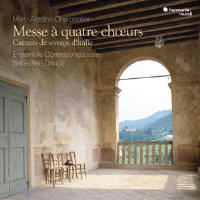|
Reviewer: William
J. Gatens
It is well known that Marc-Antoine Charpentier (1643-1704) spent about three
years in
the late 1660s studying in Rome, where his principal teacher was Giacomo
Carissimi (1605-74). He became an exponent and champion of the Italian
style, though one might say that he spoke the Italian musical language with
a French accent. As Graham Sadler points out in his notes to this recording,
there was considerable antipathy in France toward Italian music. For many,
the reserved and graceful style of French music was considered preferable to
what some listeners considered the excesses of Italian music. Such views did
not always work to Charpentier’s advantage. None of the music he wrote
before his Italian studies has survived, but Sadler points to his setting of
the antiphon ‘Sub Tuum Praesidium’ (H 28) for three unaccompanied voices as
typical of mid-17th-Century French music. Its economy and reserve make a
strong contrast with the principal work on this program, the Mass for Four
Choirs (H 4), probably dating from 1671. It is the fruit of Charpentier’s
first-hand experience of Roman polychoral church music, and is the only
surviving polychoral work by a French composer of that period. Charpentier
would have become familiar with the music of Rome during his time there, but
the program of this recording, subtitled An Italian Travel Diary, assumes
that he would have visited the principal musical centers of northern Italy
on his way from Paris to Rome.
The other works here are ones that Charpentier may have heard on his
journey. Maurizio Cazzati (1616-78) was Maestro di Cappella at the church of
San Petronio in Bologna. His double-choir motet ‘Salve Caput Sacrosanctum’
is in honor of the city’s patron saint. The Venetian polychoral tradition is
justly celebrated in the works of the Gabrielis and Monteverdi. Francesco
Cavalli (1602-76), better known today for his operas than his church music,
was music director at St Mark’s in Charpentier’s day. His Magnificat for
three choirs is a highly impressive work, almost upstaging the Charpentier
Mass. Two of the three choirs combine voices and instruments, while the
third choir is purely instrumental. Passages for groups of accompanied solo
voices alternate to great effect with imposing statements by the full
forces. One suspects that Cavalli was drawing on his flair for theatrical
composition in this liturgical piece. It is easy to imagine the overwhelming
impression this music must have made in the majestic space of St Mark’s.
Tarquinio Merula (1594-1665) was in charge of music at Cremona Cathedral
until 1655. He is noted for his ground bass compositions.
The Vesper psalm ‘Credidi
Propter Quod’ is an example. It is for a solo bass with two violins and
continuo. The vocal part demands considerable virtuosity with its two-octave
range, wide leaps, and daunting roulades.
The Roman polychoral tradition was as spectacular as the Venetian,
if not more so. There is documentation of Masses written for as many as 12
choirs. The tradition is represented here by movements from the Mirabiles
Elationes Maris Mass by Francesco Beretta (c1640-94) and the Crucifixus from
the Si Deus pro Nobis Mass by Orazio Benevoli (1605-72). The only surviving
source for Beretta’s 16-part Mass is a manuscript compiled by Charpentier
from the now lost part books.
The performances are by a choir of 18 voices and a small orchestra of period
instruments. They are beautifully stylish and technically un-impeachable.
Balances may not always be ideal, but that is a minor quibble. Readers
looking for a first-rate recording of the Charpentier Mass will not go
wrong. The other works on the program will give great delight and an
historical context for Charpentier’s artistry.
Fermer la fenêtre/Close window
|




